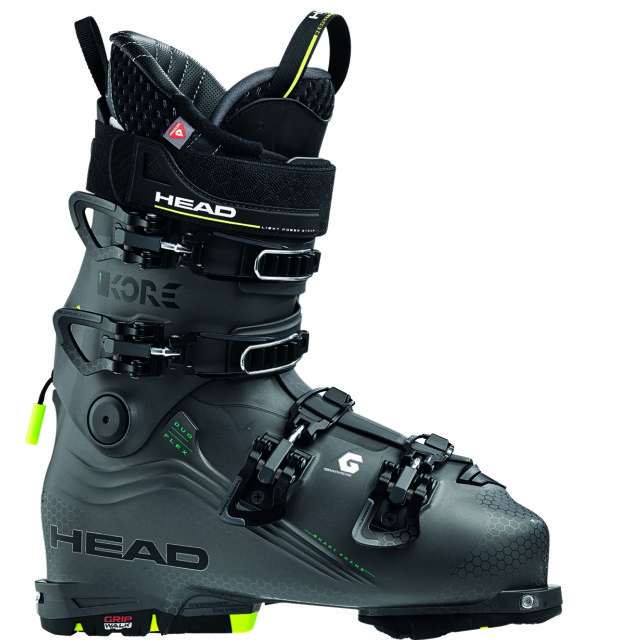
Boot: Head Kore 1 – 18/19
Stated Flex: 130
Available Sizes: 23.0-30.5
Stated Last (mm): 98 (25.5); 100 (26.5); 102 (27.5)
Stated Range of Motion: 45°
Stated Forward Lean: 14°
Rample Angle: 4
Size Tested: 26.5
Boot Sole Length: 305 mm
Blister’s Measured Weight:
- Shells, no Liners: 1132 & 1136 g
- Liners, no footbeds: 392 & 391 g
- Shells + Liners: 1524 & 1527 g
- Removable Spoilers: 29 & 30 g
- Stock Footbeds: 30 & 30 g
Buckles: 4 (upper 2 have buckle catch)
Powerstrap: 40 mm Velcro
Shell Material:
- Cuff: “Grillflex” with Graphene
- Shoe / Clog: “Grillflex” with Graphene
Soles: GripWalk (replaceable; alpine soles available)
Binding Compatibility:
- All pin-style / “tech” bindings
- “MNC” bindings (e.g., Salomon Warden; Marker Duke / Griffon ID, etc.)
- “GripWalk”-compatible bindings
Tech Fittings: Dynafit Certified
MAP: $799
Intro
While 2018 is technically the year of the dog, in the ski industry, it appears to be the year of the lightweight, 130-flex touring boot. For the 18/19 season, we’ll see additions to this category from Fischer, Tecnica, Full Tilt, Lange, Rossignol, and Head.
Head’s offering is their brand-new Kore line of boots, consisting of the 130-flex Kore 1 and 120-flex Kore 2. We’ve already spent some time on the Kore 1, and Blister Members can check out our Flash Review for our initial on-snow impressions. But while we spend more time skiing in the boot, let’s check out the features and fit of the Kore 1.
Here’s what Head says about the Kore 1:
“The new Kore Series of boots were designed to deliver lightweight, upward mobility with exceptional downhill performance.”
Nothing about this description is wildly different from what many of the other manufacturers are saying about their lightweight 130-flex touring boots, but we’ve found that the actual on-snow performance can vary significantly between the many boots that claim to offer both “upward mobility” and “exceptional downhill performance.”
Weight + Comparisons
For reference, below are a few of our measured weights for some other notable boots (keep in mind the size differences). Our measured weights show the size of boot, then the weight of each boot + the weight of each liner, then the total weight for shells + liners, listed in grams:
Scarpa Maestrale RS (24.5 / 25.0): 1053 & 1057 + 244 & 245 = 1297 & 1302 g
Tecnica Zero G Tour Pro (26.5): 1099 & 1100 + 210 & 211 = 1309 & 1311 g
Atomic Hawx Ultra XTD 130 (26.5): 1124 & 1128 + 271 & 276 (lighter pre-production liner) = 1395 & 1404 g
Head Kore 1 (26.5): 1132 & 1136 + 392 & 393 = 1524 & 1527 g
Salomon S/Lab MTN (26.5): 1257 & 1246 + 288 & 303 = 1545 & 1549 g
Fischer Ranger Free 130 (26.5): 1204 & 1204 + 348 & 351 = 1552 & 1555 g
Lange XT Free 130 LV (27.5): 1472 & 1473 + 376 & 376 = 1848 &1849 g
Full Tilt Ascendant (27.5): 1613 & 1615 & + 3018 & 311 = 1921 & 1962 g
Liner
The Kore 1’s liner is one area where it definitely differs from many other boots in this category.
First, it’s just a pretty beefy liner compared to those in other touring boots such as the Atomic Hawx Ultra XTD 130 and Tecnica Zero G Tour Pro. The ankle area of the Kore 1’s liner isn’t as thick as most alpine liners, but the cuff of the Kore 1’s liner feels pretty substantial. The Kore 1’s liner also features the standard flex bellows on the back for touring mobility, as well as a removable plastic spoiler that attaches to the liner via a velcro patch.
Second, the ankle area of the Kore 1’s liner is thermoformable, which should help people get a better fit in that area.
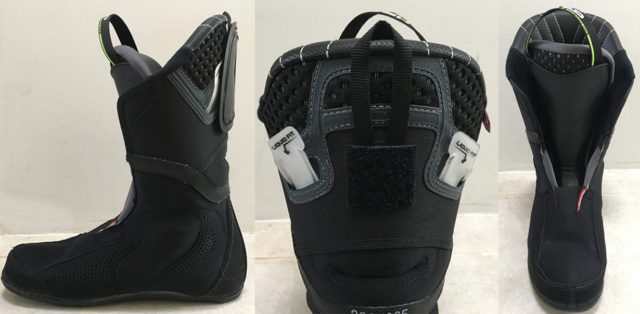
Lastly — and this is where the Kore 1 is unique — the liner is compatible with a technology that Head is calling “Liquid Fit.” Essentially, Liquid Fit allows you (with the help of a bootfitter) to inject an incompressible paraffin material into the heel and ankle area, with the goal of a more precise fit as the paraffin should fill open areas. You can add or remove the paraffin at any point to adjust the fit to your liking. The liner is designed to work without the Liquid Fit additive, but if you’re looking for a more personalized fit, you can go to an authorized bootfitter to purchase the material and have a bootfitter inject it into the liner.
Walk Mechanism
The Kore 1 has a simple walk mechanism that consists of a plastic tab that blocks rearward flexion by slotting on top of a protrusion on the spine of the boot. Forward flex / ROM is controlled by the shell and buckles. The walk mechanism includes a pull tab that’s easy to grab with gloves, and while messing around with the boot at home, the walk mechanism seems easy to use so far. Simply flex forward in the boot, and push the tab into place or flip it up to switch between modes.
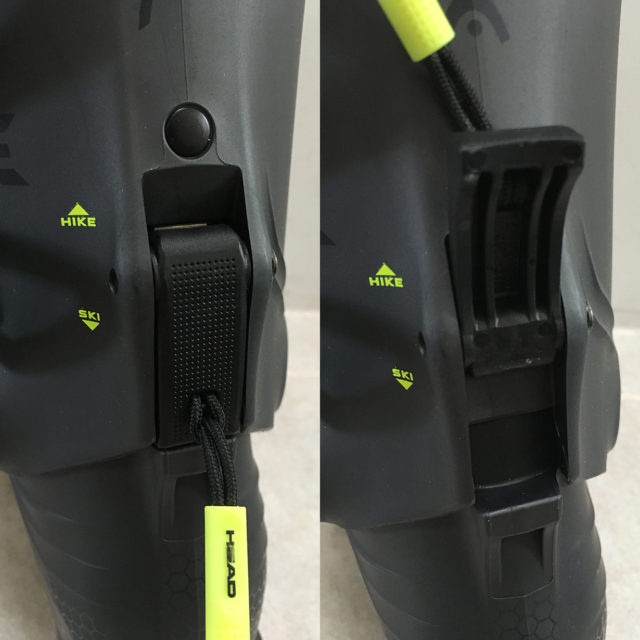
One thing we’re curious about with this walk mechanism is potential icing issues, since the Kore 1’s walk mechanism doesn’t have any sort of extra hook or latch to keep it secured like the walk mechanisms on the Hawx Ultra XTD, Zero G Tour Pro, and Scarpa Maestrale RS. It seems as though ice / snow could get between the tab and the spine of the boot, so we’ll be keeping an eye on this.
Buckles
All four buckles on the Kore 1 are attached with phillips-head screws, which should make replacement and adjustment very easy.
The two upper buckles each have a metal clasp that wraps around the standard latches (the silver oval in the picture below), which you can use to keep the buckles from coming fully undone. This is an interesting way of addressing the issue, as most other boots just add an extra, extendable latch to serve the same purpose while touring. We’ll see how useful the Kore 1’s latch is in the field.
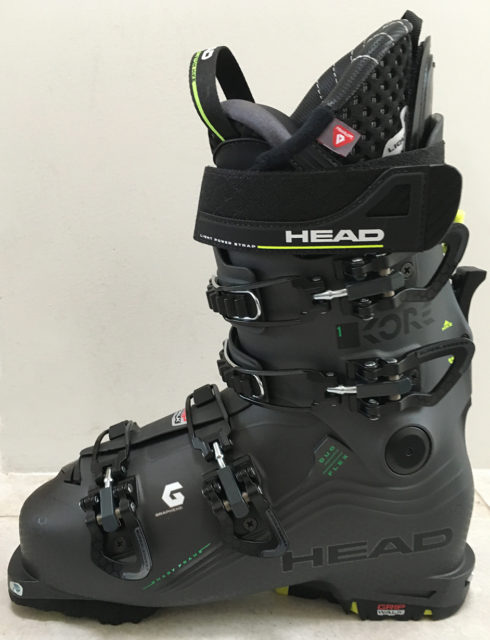
Booster Strap
The Kore 1 has a pretty standard, 40 mm velcro powerstrap with a grip at the end. Nothing surprising here.
Soles
The Kore 1 joins a growing number of boots with GripWalk soles. The Kore 1’s GripWalk soles have the usual hard plastic under the ball of the foot and the middle of the heel to work with the AFD’s on GripWalk bindings, and then rubber around the rest of the sole blocks. Like all GripWalk boots, the Kore 1’s sole has pretty minimal toe and heel rocker, especially compared to the soles on dedicated touring boots like the Zero G Tour Pro.
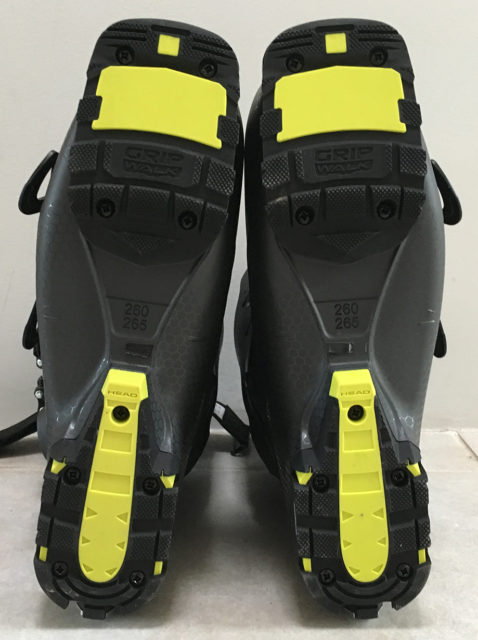
Compared to the Hawx Ultra XTD 130, the rubber on the Kore 1’s soles is less tacky and is firmer, and the Kore 1 does not have any rubber covering the arch / instep area (it only has rubber around the sole blocks). The sole blocks of the Kore 1 are replaceable, and you can purchase standard alpine soles for the Kore 1. The Kore 2 will come standard with alpine soles, with the option to purchase GripWalk soles.
We don’t expect the Kore 1 to offer exceptional grip while scrambling, but it should be a bit better than a boot with standard plastic alpine soles.
Fit
As always, we encourage (read: insist) that you go to a trusted bootfitter to decide what boot will work best for your foot. With that said, Jonathan Ellsworth and I will offer our quick take on how the Kore 1 feels on our feet.
Jonathan Ellsworth:
My feet:
Length (Left & Right): 271 & 274 mm
Width (Left & Right): 100 & 99 mm
Instep Height (L & R): 79 mm & 75 mm (The Boot Doctor’s Charlie Bradley describes this as a “high arch / high instep” — on a scale of 1-10, he calls my arch / instep a 8 or 9).
Charlie also notes about my feet: Fairly stable, solid platform. A bit of pronation. A good amount of ankle range of motion (aka, “dorsiflexion”).
I found the Kore 1 to be a very comfortable boot. The liner felt quite plush — in contrast to the much thinner Hawx Ultra XTD 130 liner I skied.
The Kore 1 is definitely roomier than the Salomon S/Lab MTN (aka MTN Lab) or Hawx Ultra XTD 130 — tighter boots that I normally ski in — but honestly, I kinda liked the extra room of the Kore 1, and unlike the Fischer Ranger Free, I didn’t blister on the inside of my heels on the way up from too much rubbing / moving.
Out of the box, with no adjustments or boot work, we’re off to a good start here. I personally still prefer a tighter, lower-volume fit, but lots of ski tourers prefer more room and plushness. If you’re one of them, I give the Kore 1 high marks for comfort.
Luke Koppa: I have a pretty average-width foot, but have large lateral splats that often cause pain on the outside of my forefoot and midfoot when running, skiing, skinning, etc. I have a low instep and an average to low arch. My feet tend to work best with boots that offer ample room in the midfoot, and have lower insteps (e.g., the Salomon QST Pro 130). Since my toes taper significantly (i.e., my pinkie toe is much shorter than my big toe), I’ve never needed a 6th toe punch in any boots.
Overall, the fit of the Kore 1 feels similar to other boots with stated lasts of 100 mm that I’ve used (e.g., the Nordica Strider Pro 120 and Salomon QST Pro 130). The Kore 1 feels pretty average in the instep area. The Kore 1’s heel pocket holds my ankle / heel pretty snugly, but with a bit of extra room. The Kore 1 doesn’t feel particularly short or long compared to other 26.5 boots I’ve used, and feels like it has enough room in the midfoot and toebox for my foot — but that can change after actually walking around / skiing in a boot for a few hours due to my lateral splats. With the factory buckle placement, the Kore 1’s cuff feels nice and tight on my skinny calves (I often have to move the buckles out on other boots in order to get this tight of a fit in the calf area).
Bottom Line (For Now)
The Head Kore 1 joins a stacked group of boots that are designed to be light and mobile enough for touring, but with downhill performance that’s supposed to be similar to a full alpine boot. The Kore 1’s customizable liner, mid-volume fit, and minimal walk mechanism seem to differentiate it from some of the competition, and we’re eager to A/B it against the many other options in this class. Stay tuned for our full review.
Flash Review: Head Kore 1
Blister members can now read our initial on-snow impressions in our Flash Review of the Head Kore 1.
(Learn more about Blister Member benefits, and Become a Blister member)

Does Gripwalk offer ANY real ,functional difference over the standard alpine norm or is the ski industry turning into the bike industry?
I find the rubber used in the sole to make the biggest difference, walking on my gripwalk boots vs alpine boots with rubber sole is not much different. But rubber sole vs my race boots is night and day.
Some people might like the “natural” walking stride that the bump provides but i’m not sold yet..
Hey,
Can I use the boot in an 2014 markee Duke epf 16 the blue orange black one? On the grip walk website it is not really clear.
Alex
The Kore 1 should work with the 2014 Duke as long as that version of the Duke has the adjustable AFD on the toe piece. The Duke with the adjustable AFD lets you move the AFD up and down to accommodate flat-soled alpine boots as well as boots with rockered soles like the Kore 1.
Worried about the walk mechanism, especially as stated, when ice or snow packs in. Any troubles on this aspect?
I bought this boot last year and have more than 100 days on it. Here is my quick review…
Skill Level: I moved to Utah as I’m a rock and alpine climber, but fell in love with skiing last year. So I’m not a pro skier but have lots of experience in the mountains and with gear (from quick ascents to big multi-month expeditions).
Ski Type: 100+ days in bounds at Alta and Snowbird and some more days at all other UT, CO, ID, WY resorts. Alta off piste is where most of the 100 days took place.
Bottom line: This boot is comfortable!
I’m not a finicky person and can deal with undialed systems, but everything feels great with this boot. Its straight off the shelf and didn’t get it fitted. I would make sure they are tight enough. I am in a 25.5 and am going to downsize to a 24.5 this week. Good thing is there are so many options but I will stick with the Kore 1. They are light and tour nicely. I am mostly backcountry skiing this season and go on at least 2 tours in the Wasatch per week. Even though they are a 130 boot, they do still flex quite a bit so if you want something really stiff, I wouldn’t count on this boot. I have not had a lever malfunction in walk mode. After walking long distances, I have had to clear ice out of the channel which takes less than 5 seconds each so no biggie. These boots are def high volume so if you want a tighter feel, this is not the boot for you.
The sole is NOT grippy whatsoever. I epic’d pretty hard on Mt Adams in a white out and ended up bushwacking over 6 miles through the pouring rain in the forest to find my way back to the log road. Not what the doots were made for lol! BUT no blisters. They were comfy the whole trudge. I am so hard on these boots and all buckles and levers are in good shape. All in all, this is a comfy boot that takes steep slopes from ice to blower pow and is super comfortable on the uphill. I ride these with Shift Bindings and DPS Wailer 112 Alchemists, Head KORE 99s, and Black Crowe Nocta (122mm). If you have a heavier ski make sure you this boot isn’t too high of volume so you maintain your control
Can they be used with carving skis with a regular alpine binding. Say for example that you only want to use one pair of boots for two pairs of skis, one pair for touring and a pair for groomed slopes.
You can buy alpine style soles that can be put on which will allow them to comply with alpine norm
Mads, I too want to know this. I like that it won’t get soft in warm weather but I assume the linear flex may not be ideal for a carving ski.
Surprised how good this boot and shell felt in the store with a much wider last than I normally would consider. Love that material can be added and removed from the ankle. The boot fitter described it at “mainly resort, some touring”? Would like to see a some longer term reviews…
Mads and Maria,
My background is in mountaineering and rock climbing and not ski racing so I wouldn’t want to steer you in the wrong direction, but I can carve just fine in these boots. Narrowest ski I have skied with these is a 99mm ( i know thats a little wider for some but I live in Utah where most skiers look like they are using 2 snowboards one on each foot lol!) I would def recommend you find a shop that will squirt the wax stuff in the ankles. It makes a big difference. I am also going to put shims/pads under my forefoot as it becomes to voluminous on tricky terrain. This is def a comfy boot and I just sized down and bought another pair. In fact, I went touring this morning on some terrible snow. Hard crust that want to pull my skis off when I broke through. My boots felt solid. I ride the Atomic Shift bindings on all of my skis so I use them in bounds and touring. Mainly skiing on DPS Alchemist 112cm skis. Maybe your question should be more toward bindings. You can get bindings that are touring, combo, or downhill and the booth should be compatible will all.
Alexander B. Whitley,
Very helpful! I size down 2x for alpine boot and tried the the Kore 1 also 2x down. Seemed like it would work. I lean to performance but touring sometimes means foot is not in the back of the boot so it’s good to hear that smaller is OK. The Atomic Hawx for touring only needed to be 1 size down in length even though there is more heel room…..
Good tips on overall setup. If it goes on sale in my size, I will buy it.
Thanks so much for the response!